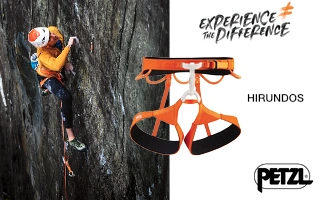James Pearson talks in depth about the second ascent of Echo Wall
- Sunday 4th August 2024
As previously reported, late last week James Pearson made the long-awaited second ascent of Dave MacLeod’s Echo Wall on Ben Nevis in Scotland; James shares the details and his thoughts about the experience and route.
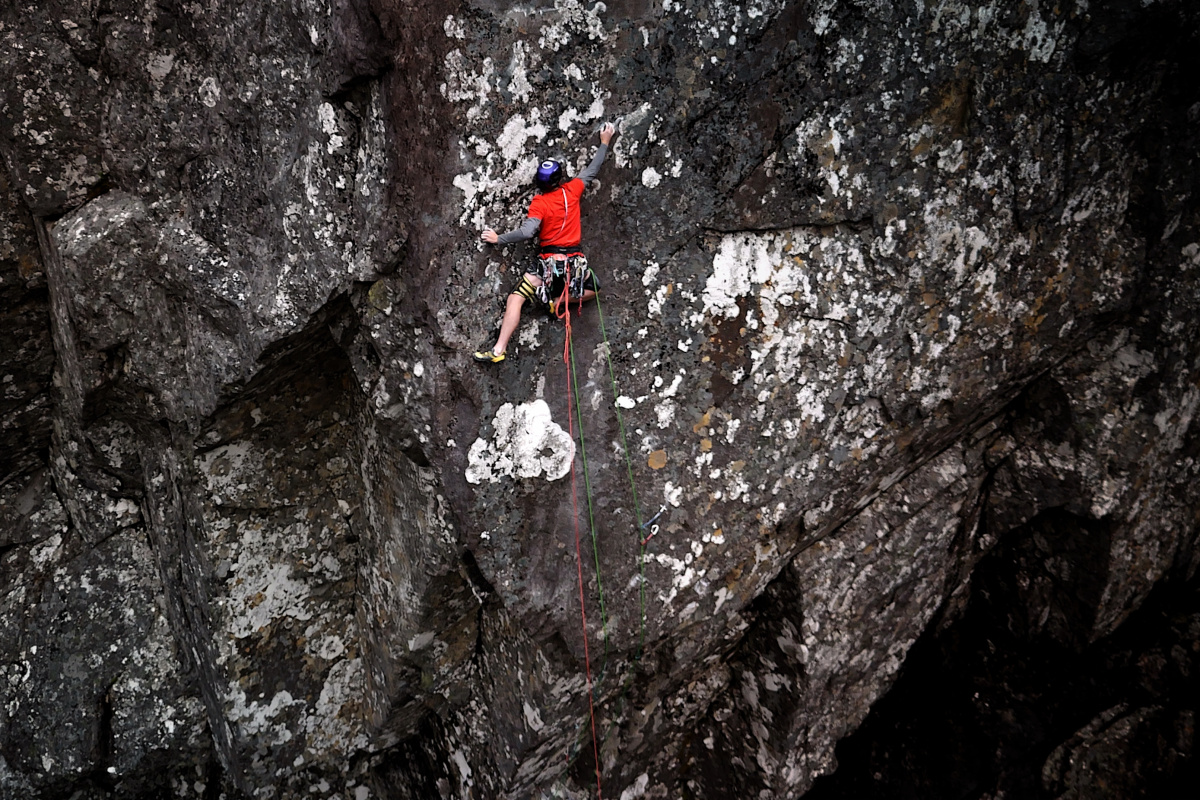 2008 was a pretty big year for trad climbing. Over in Yosemite, Beth Roden made the first ascent of her testpiece, Meltdown (5.14c/F8c+), Pete Whittaker made the first ascent of Dynamics of Change (E9 7a) on Burbage, Team USA ran wild with Hard Grit repeats galore often ground-up and on-sight/flash, James Pearson made the first ascent of The Groove (E9 7b) at Cratcliffe whilst big news from north of the border was that Dave MacLeod made the first ascent of Echo Wall (E??).
2008 was a pretty big year for trad climbing. Over in Yosemite, Beth Roden made the first ascent of her testpiece, Meltdown (5.14c/F8c+), Pete Whittaker made the first ascent of Dynamics of Change (E9 7a) on Burbage, Team USA ran wild with Hard Grit repeats galore often ground-up and on-sight/flash, James Pearson made the first ascent of The Groove (E9 7b) at Cratcliffe whilst big news from north of the border was that Dave MacLeod made the first ascent of Echo Wall (E??).
Of all those ascents, Echo Wall stood alone in being high in a mountain environment; that brought its own special issues. Firstly, the weather and the conditions. Secondly, the consequences of a rescue/evacuation should an attempt end with an incapacitating fall increased the risks of the route even further. And thirdly, the physical aspects of attempting such a “remote” climb some three hours walk from the nearest road. That Dave MacLeod had successfully overcome these, and undoubtedly more issues, showed that these weren’t insurmountable. Clearly however, they added considerably to the already daunting task facing any prospective suitor.
Before we bring James into the conversation let’s review what we’ve known about Echo Wall until relatively recently. For starters, Dave MacLeod spent considerable effort prior to his first ascent preparing the ground – quite literally – in this case shovelling snow off the ledges at the top of the route so that it would dry earlier so that he could begin his attempts as soon as possible to maximise his chances.
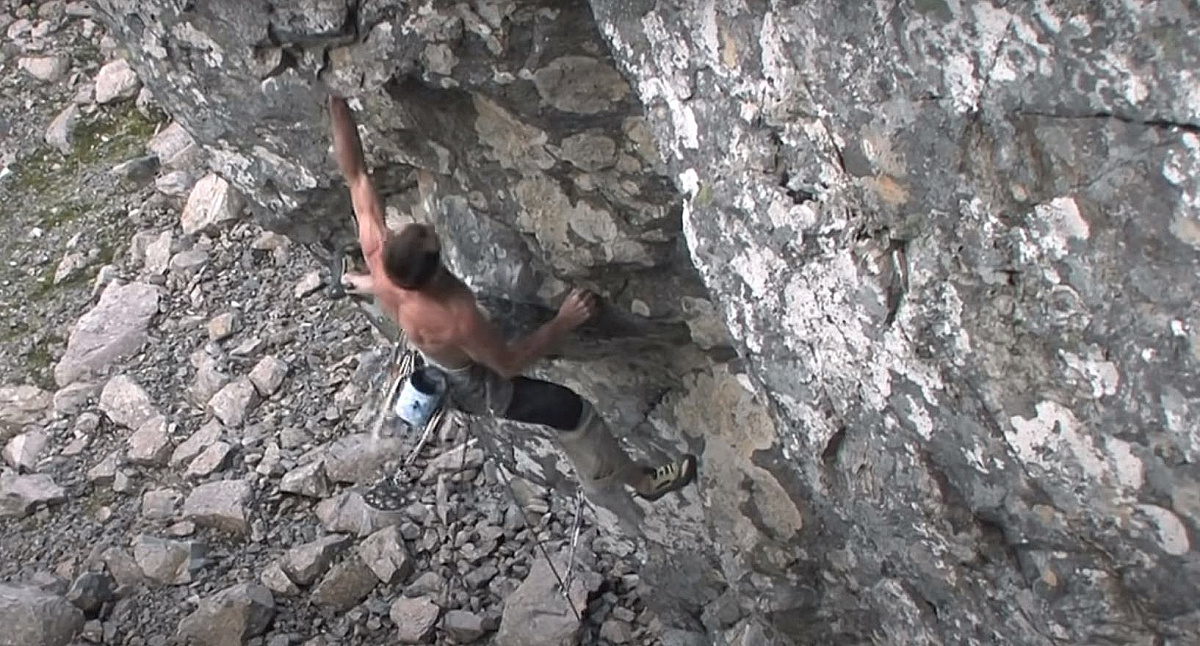 Although he made the first ascent of Echo Wall two years after his first ascent of Rhapsody at Dumbarton, Dave described the climbing on Echo Wall saying it was the hardest route of his life. Somewhat unusually for that period, however, he left it ungraded. A film about his first ascent followed but still no grade was forthcoming from Dave.
Although he made the first ascent of Echo Wall two years after his first ascent of Rhapsody at Dumbarton, Dave described the climbing on Echo Wall saying it was the hardest route of his life. Somewhat unusually for that period, however, he left it ungraded. A film about his first ascent followed but still no grade was forthcoming from Dave.
Watch a short trailer for that film here:
Later that autumn Dave wrote a blog post (read that here) describing the difficulties of the route and specifically addressing the issues surrounding the grading dilemma. “It’s been an interesting experiment, climbing the hardest route of my life but not giving it a grade. Contrary to what some people seem to be thinking, this was not to make any particular point, merely because I didn’t know what to grade it.” Dave wrote.
It’s increasingly common these days amongst some top climbers but back then Dave was clearly frustrated with the focus given to the grade of his new routes and/or repeats rather than taking a more holistic view.
Dave expanded on this in his blog post saying: “…it always irritated me that the grades of my routes or repeats ended up at the centre of the discussion, rather than at the fringe where they belong. I have noticed people even referring to my climb Rhapsody as ‘E11’ as if that were its name rather than an insignificant and rather meaningless number attached to it. Part of the reason writing this blog is useful is that I can answer questions folk commonly ask and hopefully steer the chat back towards what’s important - the climbing - and away from grading (ha! he says, optimistically). Anyway, perhaps some more details will help folk get on with pigeonholing a beautiful climb into an ill-fitting picture."
"Right now, I still have no idea what to grade Echo Wall, so I’m not going to at the moment. Perhaps at some point, I’ll have repeated some more routes given E grades in double figures and have a better idea. Grades evolve. With few references to go on, they are pretty shaky. Once there are more routes and more climber’s opinions on them, they become a bit more useful. Echo Wall is much harder than any trad route I’ve ever done or tried, that's all I know right now."
Moving the conversation away from the grade and back towards the climbing Dave wrote about what he was looking for at that time and the experience he had whilst making the first ascent of Echo Wall:
“Quite apart from the line and the mountain, I was really inspired by making a route that had the combination of F8c or harder climbing, an uncompromising level of seriousness (which, if you need it spelt out, means you would die if you fell off it), and a remoteness of situation that would create a logistical challenge of actually working on the climb. Echo Wall was perfect in this respect. None of the Ben’s hardest routes to date have had high-standard physical climbing. Why? Because it’s just not practical. It’s covered in snow, rain, mist, lichen or moss 99.9% of the time. Go to somewhere like the lakes and you’ll get nice weather, nice chilled approaches and pretty small and convenient crags. When I first began to think about trying Echo Wall, I figured I would be able to absorb this hurdle and that the climbing would be the main problem. The climbing challenge was to be able to climb F9a at the same time as spending lots of time in the mountains to have a realistic chance of linking Echo Wall on a top rope. As it turned out, this was the easy bit!"
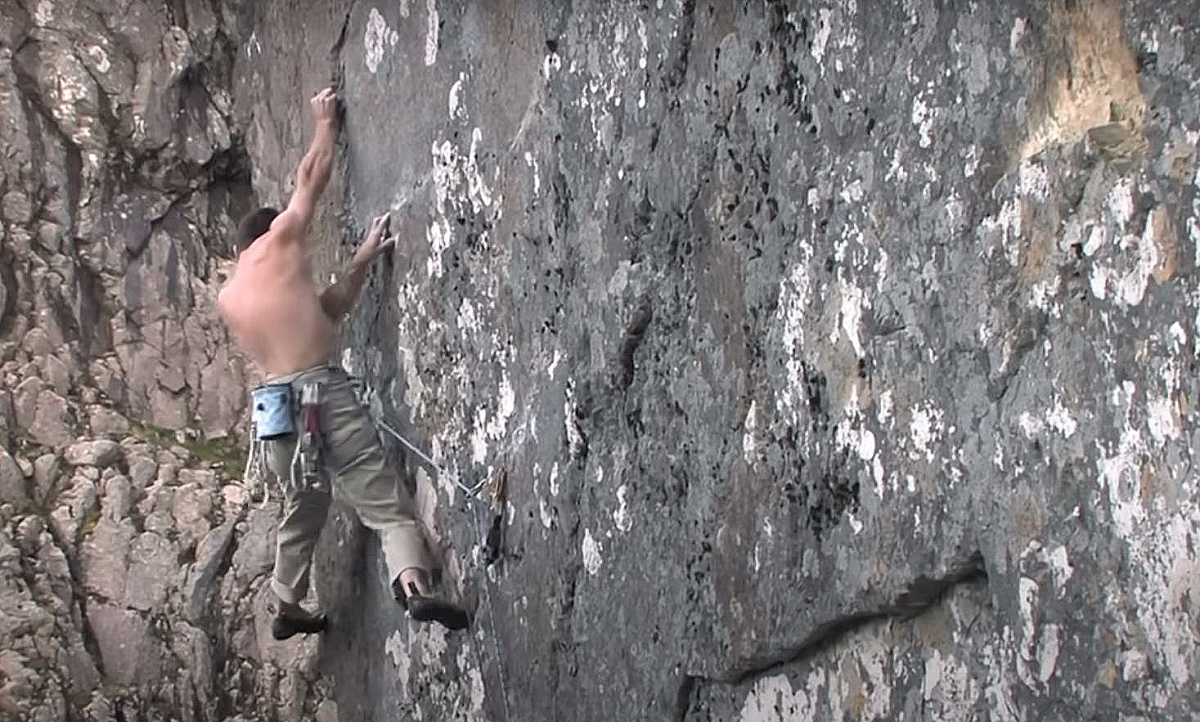 Drawn back towards the grading issue Dave added: “My headache here is how should this be reflected in the grade? We have trad routes given big grades like E9 or E10 that are completely piss on a toprope (like F8a+ or easier) but their grades stand the test of repeats because of either seriousness or mountain situation (often stretched quite a bit!). I actually agree that proper mountain trad routes should have some recognition of their remoteness and awkwardness reflected in the grade. Echo Wall feels like F8c/+ on a top rope, with the real prospect of death from the redpoint crux, on a crag with more logisitical issues than any other mountain crag in the UK."
Drawn back towards the grading issue Dave added: “My headache here is how should this be reflected in the grade? We have trad routes given big grades like E9 or E10 that are completely piss on a toprope (like F8a+ or easier) but their grades stand the test of repeats because of either seriousness or mountain situation (often stretched quite a bit!). I actually agree that proper mountain trad routes should have some recognition of their remoteness and awkwardness reflected in the grade. Echo Wall feels like F8c/+ on a top rope, with the real prospect of death from the redpoint crux, on a crag with more logisitical issues than any other mountain crag in the UK."
"Do you see my problem? I am uncomfortable with the feeling of grades advancing too quickly due to overgrading, but on the other hand feel that Echo Wall might well earn a laughable quanta of E points over anything else I’ve done, based on the way the E scale has been used traditionally over the past couple of decades. I just don’t know."
"Grades will always be very shaky and mobile at the cutting edge, but it would be a shame for these grades to lose any credibility they did have just because the standard going through a period of rise. On the other hand, if you really believe a route is a certain grade, it’s important to just be straight up and make the proposal. James Pearson has just done this with a stunning-looking new line in Devon. An inspired piece of work from one of the world’s top climbers in the trad and bouldering disciplines right now. And top effort for sticking his neck out and pinning the E12 grade to a climb for the first time."
"So what is the solution to all this uncertainty? Like most hard truths, you knew it already - time and repeat ascents. It will take climbers to drag themselves to these corners of our isles and make the time to get these things repeated. Until then, comparison between them is a fool's errand. For that reason, Echo Wall is ungraded, for now. It doesn’t matter, because the interesting part is the story of the ascent, and I’ve not been nearly so cautious in making sure it can be heard!"
Finally, Dave concluded his blog post with details on the difficulty of the climbing and protection:
“Echo Wall took me longer to link on a top rope than A’ Muerte (F9a), i.e. Many days, while in Spain I was able to consistently climb F8b+ and F8c in a day. Echo Wall is F8a+ up to the roof at 12m, with the smallest BD micro cam for gear. This section is comparable with If Six Was Nine E9 in the Lakes. At the roof, I could get about 40 seconds rest out of the kneebar."
"After the roof is the technical crux. There are three bits of gear protecting this - a poor Camalot in a very shallow slot, a good wire but in a suspect tooth of rock and wire in dubious rock. It’s dubious because there used to be another wire placement right beside it which was the best of the lot, but the placement broke and fell off randomly in between my visits. Scary! Right after the crux, there is an RP3, quite good but blindly placed. Then a runout to a shakeout. The shakeout isn’t so good, and afterwards, there is a final hard section and this is where I fell many times when trying to link it. There is an RP and very poor skyhook at the shakeout, but the placement is in a loose flake of rock so I’m pretty sure they would just pull right through if you fell here. You have to do the final boulder problem pumped, knowing if you fall you will die.”
Prior to James’ interest in Echo Wall Steve McClure is the only known climber who had actually invested any effort in looking at Echo Wall; sadly however, the infamous Scottish weather played its ace card and heavy cloud/mist prevented Steve from even finding the route and he spent an entire day walking blindly around The Ben is a classic a pea-souper! This did little to erode the mystic surrounding the route!
Fast forward to March of this year, Dave released a video (link here) in which he talked about how he grades his routes. As a very interesting aside Dave – renowned for being a 'harsh grader' – reflects on the grade for The Longhope Route – a route which he originally gave E10 but James McHaffie suggested was E9 after he repeated it.
Specifically, Dave addressed Echo Wall in this video and finally offered his retrospective thoughts about a grade for Echo Wall. On reflection, and with further experience – both of which he talks about at some length – he concludes that he might have overestimated the climbing difficulty of Echo Wall but believes now it’s “at least F8b but that F8c might be a bit generous”. Likewise, his reflections on the adjective grade are “framed” by what he thinks the grade boundaries for Echo Wall might be. In this, he suggests Echo Wall is that it’s “at least E9 but if Rhapsody is E11 (bottom end) then Echo Wall could be mid E11”. Concluding his thoughts however on the likely grade for Echo Wall which sits somewhere between the E9 and E11 boundaries, Dave suggests that “Echo Wall is E10”.
So let's get bang up to date and bring in James Pearson; a man seemingly on a mission to repeat all the top-end trad routes around the world. Since repeating Dave MacLeod’s Rhapsody several years ago, James has recently made swift repeats of numerous hard trad routes in the UK including Neil Gresham’s Lexicon (E11), James Taylor’s Prisoners of the Sun (E10 7a), the first “post-break, gear placed on lead” ascent of Parthian Shot (E10), Franco Cookson’s Immortal (E11 7b) as well as making the first ascent of his own Annot testpiece Bon Voyage which he has subsequently given E12.
James’ repeat of Echo Wall is pretty remarkable; knocking off such a mythical route in a short visit from France in what was his summer holidays during a pretty lousy summer shows what level James is operating on. James also pays tribute to Dave MacLeod’s vision in climbing such a route back in 2008. The irony that it is James who has repeated Echo Wall will not be lost either on those who have been around a while; remember James’ route The Walk of Life harks back from 2008 also and it was Dave MacLeod who did the first repeat of that soon after James’ first ascent. Remember too the swinging downgrade that followed that repeat!
James’ thoughts on Echo Wall
Here then are James’ thoughts on his second ascent of Echo Wall:
Congratulations on repeating Echo Wall. That’s yet another top-end trad route added to your already considerable list; how pleasing was the whole process and the outcome?
Thanks a lot! Right now I’m in a bit of a state of disbelief. With hindsight, I feel like the experience was really enjoyable, and the process from start to finish was one of my proudest journeys in climbing, as I feel like I managed everything quite well and didn’t really waste any time. Looking back I can also see how lucky I got with the weather up there, and although it rained a lot, it generally came at quite convenient moments when I needed a rest day or two anyway.
However, in the many moments sat in the van or the Climbers' Club hut watching the rain fall, I have to admit to feeling a little disappointed/frustrated with the situation. There were also several times up on the ledge below the route, alone in the clouds and watching the moisture condense on my gear, where I really asked myself “What am I doing up here”?
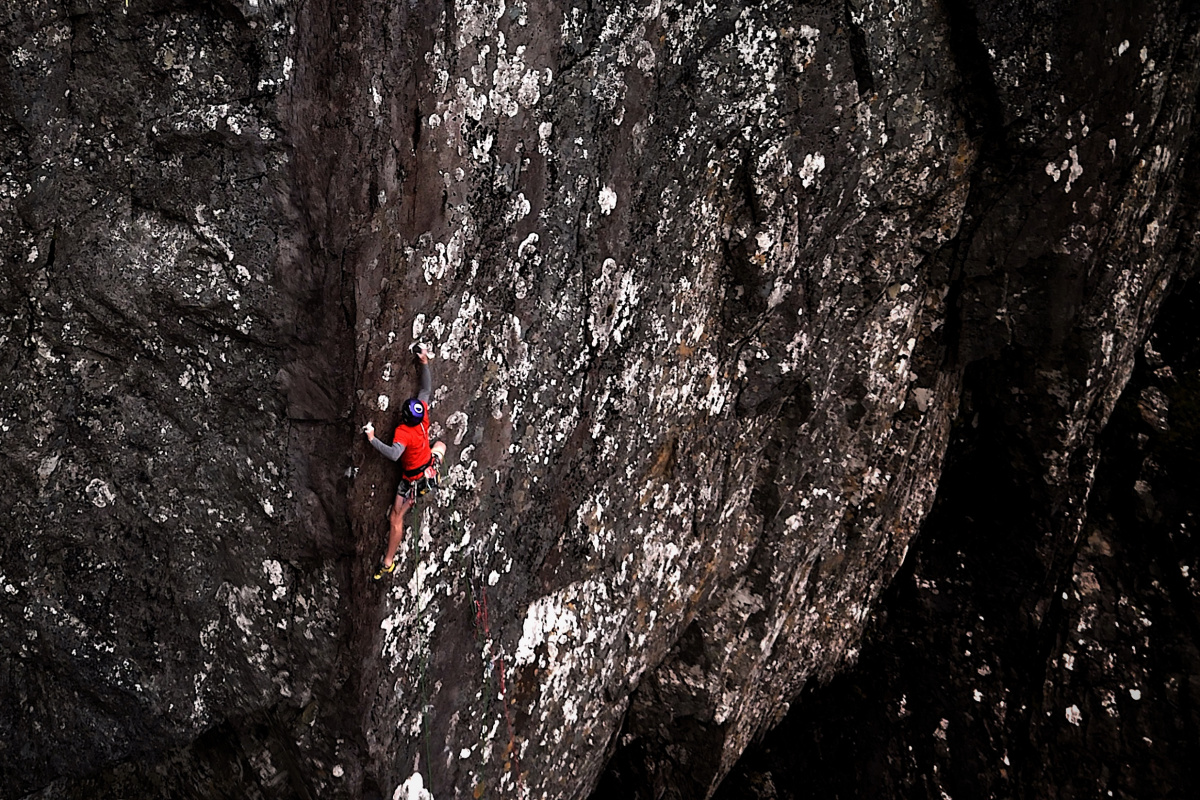 You’re married, have a young family and live abroad and on the face of it Echo Wall doesn’t sound like a perfect project for someone in your position so before we do a deep dive into Echo Wall, perhaps you can say when and why you choose Echo Wall has a major project for this year and what appealed to you about Echo Wall the most?
You’re married, have a young family and live abroad and on the face of it Echo Wall doesn’t sound like a perfect project for someone in your position so before we do a deep dive into Echo Wall, perhaps you can say when and why you choose Echo Wall has a major project for this year and what appealed to you about Echo Wall the most?
Echo Wall definitely has a serious reputation, both for the actual climbing/danger, as well as its logistical complications, and it’s exactly for those reasons that I’ve not been to try it before. However, since climbing Bon Voyage in 2023, it took the top spot on my list of things I wanted to try and I started to make plans for a visit to Scotland. At first, I didn’t take things very seriously and thought I might just be able to nip across at the last minute if ever I saw some high-pressure moving into place. Safe to say that didn’t work, and so the next summer whilst on a family holiday in North Wales, the plan was to keep an eye on the weather and go up there if ever I saw a good few days on the forecast. That didn’t happen either.
Finally, this year, I realised I needed to actively commit to being in Scotland for a serious amount of time if I wanted to have a chance to do it. Originally I thought about coming over for most of the summer holidays, renting a house for my whole family, including my parents so someone could look after the kids, allowing Caro and I to head up the mountain. Unfortunately, life threw a bit of a spanner in the works and financially that was no longer a possibility, but I could still manage a two-week trip on my own in the van with the possibility that Caro could join me later on if ever I felt ready for an attempt.
In all honesty, with such a short amount of time, I didn’t even dream of being able to actually climb the route and was happy enough with the idea that even in one of the wettest seasons in recent years, surely in two weeks there was probably going to be a moment I could get a rope down the route and have a look at the holds and the gear. Like that, I’d be able to have a very rough idea of the difficulty and the danger and decide if I wanted to seriously commit to the project in the future.
What did you know about Echo Wall before starting this process and what did you anticipate would be the main issues to contend with on Echo Wall before you arrived?
Like most people, I didn’t really know much about the route. Since Dave climbed it back in 2008, as far as I’m aware, nobody else has even been to try it, and whilst Dave certainly wrote a lot about the route on his blog at the time, more recent, information he shared about the route painted a slightly different picture, so it was hard to imagine what I would actually find. The only thing I was sure about was that getting up there would probably be a pain in the nuts and that my general “all-day-long fitness” would probably be an issue… Since having kids my climbing sessions are usually quite short.
How detailed a game plan did you have before coming to the UK for Echo Wall and what specific training did you do to prepare yourself?
Without ever having been on the route it’s hard to create a specific plan, so I generally focused on increasing my power endurance, especially on crimpy holds. After a season of bouldering around Ailefroide, my fingers were feeling quite strong, and I was pretty sure I wouldn’t find any of the sections of the route particularly difficult, but I needed to convert some of that power into endurance, so two months before heading over I started doing lots of circuits on our home wall. Ollie Tor from Lattice has been really instrumental in my own progression over the last few years, and it was no different for Echo Wall. Leaving for the trip I felt pretty fit, which is always a nice place to start from.
You posted daily stories on Instagram whilst trying Echo Wall about what you were doing and approaching the route. Did your attempt unfold as you imagined or did you have to switch up your plans at any stage?
The thing I really enjoyed about posting all of those stories was that I was genuinely discovering everything for the first time with everyone else. I think that’s part of the reason why they worked really well. There are lots of climbers out there with just as many questions about this route as myself, and so the viewers had the feeling they were on this journey of discovery with me. I felt really grateful for the daily messages of support from people, and they definitely helped carry me through some of the wet days and the disappointing sessions on the route. A special thanks goes out to some of the Fort William locals I met who helped me out with logistics and weather advice, and even lent me specific bits of gear to try. It was wonderful to feel welcomed and supported by the guides who spend more time on the hill than anyone else.
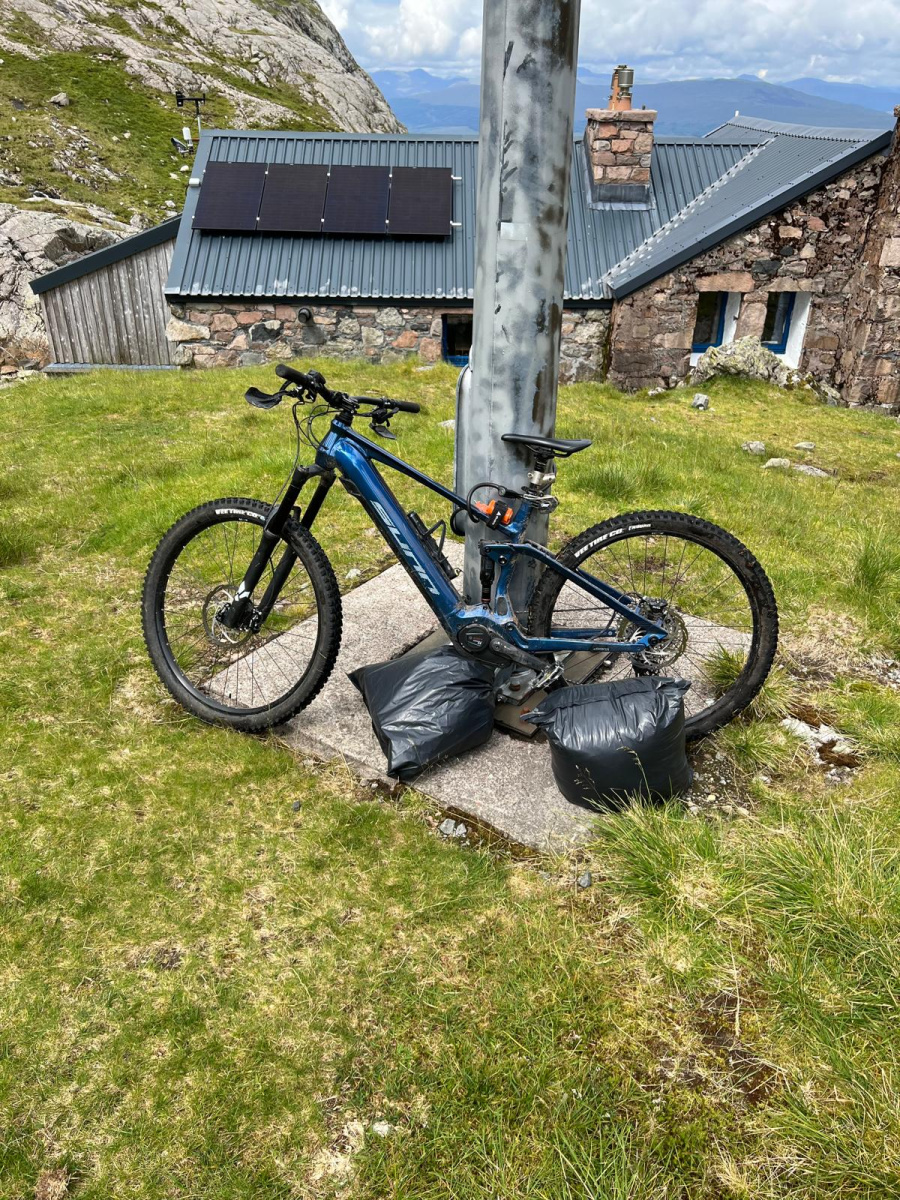
As an aside, you used an electric bike on the approach to the CIC Hut and then stayed in there some nights as well. Were they the game-changers that they seemed?
Actually, I only stayed in the CIC hut once, I was mostly in the Climbers' Club hut in Roy Bridge. I used an E-bike most days to access the route, at least as far as the CIC hut. It’s significantly faster than walking, and once most of my gear was stashed up at the route, I felt like it was also less tiring for me than the walk. However, the path isn’t the easiest to ride, so before other people start thinking this might be the future for all climbing on the Ben, I just want to add a caveat that you need to be a fairly proficient mountain biker for it to work. Caroline has been riding mountain bikes on and off for a few years now and she found the ride up really tough on our first day together. On the day I led the route we walked up together.
Let’s get specific then. What was your first impression of the approach and Echo Wall in general and then the various sections of the route – say the lower wall, the kneebar and then the upper wall?
My first impression of Echo Wall was pretty positive. I managed all of the moves and all of the individual sections on my first climbing day, and at that point believed that I would be able to link the route together really quickly. I wasn’t very impressed with the protection in the upper wall and found the lower wall really hard to work, and also the protection less reliable than I’d imagined.
Over the days to come, I realised that linking things together would be a lot harder, but inversely my feelings about the protection gradually improved. It’s a very intimidating place to climb, and you often have to deal with less than perfect conditions. In general, it’s really easy to overgrip and waste energy on the route, and the key to eventually being able to link everything together was just spending time up there and allowing myself to slowly feel more comfortable and confident.
For the record how many days did you spend working on the route in total on a top rope/shunt and how did that go?
I walked up to the route eight times in total. The first was just to get a rope in place, the second was in the rain, and I led the route on my sixth climbing day. This was all spread over a period of two weeks.
During that initial process, you must have been comparing it to other hard routes you’ve done recently like Lexicon and Bon Voyage even if that was subconsciously. Can you share your thoughts on any comparisons you had at the initial stage?
Compared to Bon Voyage, the moves themselves are a lot easier, and the climbing is a lot less pumpy. Compared to Lexicon the crux is a lot harder, but the climbing on Lexicon is a lot more resistance-based, meaning the difficulty comes from the culmination of many difficult moves rather than one short extreme section. Overall, for me, Echo Wall feels harder than Lexicon but easier than Bon Voyage. Whilst time invested is not a perfect way to judge things, it does give you a decent idea of how things stack up against one another. Lexicon took me two climbing days, Echo Wall took me six climbing days, and Bon Voyage took me over 20 although as Bon Voyage was a first ascent, that significantly lengthened the process.
Once Caro joined you it seemed you led the route very quickly therefore after. Firstly, you lead it with preplaced gear and with the static rope backing up the crucial headwall gear; how did that go and how much did that help with the actual lead?
I always try to get on the lead as soon as possible, as I think not only do I climb better on lead than on top rope, it gives me a much better idea of what to actually expect on the big day. Switching from top rope directly into a real lead attempt can be a pretty brutal transition. There are still a lot of things that you need to learn about the placements and rope management that you can only really find out on the sharp end.
Most of the gear on the lower wall of Echo Wall is reasonable (if placed well) and this allowed me to feel like I was on a run-out sport route during my first attempt using pre-placed gear. It was also the first time I got to climb that section without the additional complication of pulling my rope through my belay device, and the first time I realised that linking the moves together is actually not that bad.
The protection in the roof is also quite good, as long as it is placed well, and whilst the boulder problem around the roof is a little bit run out, I was really happy to try this on the lead. Where things get complicated is with the upper gear on the finger flake, and this is why I chose to back it up with my static rope for this first lead attempt. Like that, I could concentrate purely on the climbing without any fear. Linking the route for the first time like this gave me a huge confidence boost, and from that point on I knew it was a question of not if, but when. Unfortunately in Scotland, 'when' can often be a very big problem, and my luck with the weather had finally run out.
I hesitated about trying to lead the route for real on that same day as I knew conditions were the best I was going to get, but although I was really excited at the prospect, deep down I knew I was probably too tired. Although I thought I might be able to scrape through and make it happen, I didn’t want to feel like I was too close to the limit. It looked like we might get another weather window the following afternoon, after some showers in the morning, and I decided that that was the best overall plan.
What was your thought process on deciding to go for the lead and how confident were you?
Whilst I knew I could potentially fall off the crux just after the roof, or even in the lower wall, I was reasonably confident that if the conditions were good, I’d have a good chance of pulling it off. Once on the headwall, I believed I had the capacity to stay calm and recover enough to confidently climb the final boulder, I just needed to arrive there without going too far into the red on the lower moves.
Can you give a breakdown of the route saying how hard you found the various sections – say up to the roof, the kneebar 'rest', the crux on the lower headwall and then the final section after the last gear?
The route can be broken down as follows:
Several easy moves lead to a no-hands rest bridging in the corner. Unfortunately, this is now very wet, and whilst the climbing remains easy, it’s really annoying because your feet and hands get wet for the harder section above.
Another few easy moves allow you to place the first three pieces of gear and get to another no-hands rest jammed into the corner above. On the day of the lead, the regular holds I used here were wet so I had to invent a new sequence on the fly.
Here the climbing gets very steep. You place the first of the crucial pieces in the bottom wall, make the first of the harder moves, and find yourself at the beginning of the crux of the bottom wall (probably the most physically powerful move on the route) where you have to place another crucial piece of gear. From here you down-climb back to the floor.
With most of the gear on the bottom wall already placed, you can speed back up to the crux and commit to the very powerful boulder. I managed to get a vague knee scum to help with this move, which felt easier than the dynamic drop knee that Dave used. A couple more powerful moves lead you through some big undercuts, and whilst these are not that hard, they are quite energy-snapping. A reasonable hold allows you to stretch up and place the best gear in the whole route just under the roof, but unfortunately, you place it all off the same hand so you get pretty tired. Another three moves lead you up into the roof and into the salvation of the knee-bars. I actually found them reasonably good and could rest using alternate knees, which must have been an improvement over Dave’s single knee rest. Instead of using the Friend 6 like Dave, I found a tiny slot just next to that where I could place a number 1 Ball-nut. The ball nut seemed pretty good as long as it is placed precisely, and it’s a lot lighter to carry than a massive cam!
The crux of the route comes just after the knee-bar rest. A powerful and crimpy boulder problem with holds that are awkward to take as perfectly as you would like, and often left my fingers feeling a little numb from crimping them so hard to ensure I didn’t slip off. You finish this sequence on two slightly better crimps from where you can place some more gear. Dave placed a single RP3 here which he thought was good, but also thought the wire would probably snap in the case of a long fall from above. I think that is a real possibility, so I chose to place a second micro-wire as a backup, though as it was the smallest micro-wire that exists, I’m not sure if it was much help.
The next section of the headwall is relatively easy in comparison, but despite the larger holds, I always got quite pumped here as the rock feels slippery and I tend to overgrip. You run it out for quite a few moves to the eventual sanctuary of fairly decent finger-flake and the most important gear of the route. Dave placed another RP here along with a skyhook, and if you read his blogs, he was pretty sure that these would rip in the case of a fall which would likely result in death.
I chose to wiggle in a lot more pieces than Dave, and whilst none of them are very good in isolation when they are all equalised together, I thought there was a reasonable chance they might hold a fall. The downside of this approach is that you get significantly more tired, as it took me about 10 minutes to fiddle in and equalise all of the pieces. I then spent a further five minutes doing my best to recover before committing to the final boulder problem. I’m sure that if I had only placed two pieces like Dave I would have felt a lot fresher for this boulder, but I would also have been way more worried knowing that the consequences of failure would be almost certainly severe.
The final bolder problem isn’t particularly difficult in isolation but is far harder than you would like it to be, with tough two-finger crimping and small insecure footholds. You need to be precise with your body movements and quite forceful with the holds (it’s difficult to relax and use friction, you have to actively control your finger position), but that approach can often lead you to feeling exhausted for the final long lock-off from a very small three finger crimp to fairly decent edge. There is a real (terrifying) possibility that you get to the crimp on the arête, having done all of the hardest moves, and don’t have the power to lock off and get the next hold and salvation!
A very good jug marks the end of all of the hard climbing. Decent protection in the form of a sling around a spike means that you are also safe, and the rest of the route is a relative walk in the park up to the ledges far above.

So let’s talk in detail about the protection on Echo Wall. Dave didn't seem that impressed with the gear on much of Echo Wall – he commented that the three pieces above the overlap were either poor or in poor rock. Once at the shakeout past the crux he got an RP #3 and a poor skyhook but again he commented that the rock was poor and believed they would probably fail if fallen onto and that would result in a ground fall. What did you think of the gear either in general or specifically?
Generally speaking, it seems like I trusted the gear a little more than Dave did on his ascent. Whilst the gear on the bottom wall is very small (the crucial hardest move is protected by a triple 0 Friend (the smallest Friend that exists) and a number 1 Ball-nut placed in slick, wet (I’m not sure if it is always wet, but it was always wet for me) rock, but as long as you take enough time to properly place and seat them, I felt like they were good pieces. That’s actually true for most of the gear on the lower wall, as long as you really take your time to place it well it’s all fairly good.
After the roof and the knee-bar rest things change quite a lot. The gear becomes a lot smaller, and the rock a little more suspect, but I was still pleasantly surprised by most pieces. There is a very good RP3 just after the roof which would quite happily hold bodyweight and even a small fall, but I’m worried (just like Dave was) that if you take a long fall onto this piece, you might just snap the wire rather than break the placement.
The protection that Dave placed in the finger-flake is not great, but it would definitely hold bodyweight (just like he said it would, which was confirmed by the fact he thought you could lower off this gear if you didn’t want to commit to the final boulder problem). Whilst Dave only placed two pieces here, I placed another two micro-wires and two sky-hooks, all equalised together with two slings, and all tensioned down to the floor with a separate thin rope that I carried up on the back of my harness.
With all of this combined, I was reasonably confident in the chance the gear might hold a fall. Let me just try and confirm what I mean here. I definitely didn’t want or plan to fall off onto it and test this theory, but I didn’t feel like I was soloing either. I climbed with the idea that I would either feel fit enough to know I could do the top boulder, or choose to lower down from here, but I also knew there was a chance I would be OK if I did push on and make a serious error of judgement. Paradoxically it is this subtle shift that makes a big difference to the likelihood that I would over-grip or generally freak out, causing me to get too pumped and be unable to complete the next crucial section!
How did the actual lead go; any dramas?
Apart from the bottom of the route being a lot wetter than ideal, forcing some last-minute sequence changes, and generally taking a lot more time than expected to place all of the gear, especially the aforementioned top cluster, which really tired me out by the time everything was in place, the lead went surprisingly smooth. I didn’t feel as fresh as I would have liked in order to make the top boulder feel relatively easy, but I also had a little margin still to give.
Overall then what kind of experience did you have repeating Echo Wall; did it pan out as you thought it would and what are your thoughts on how Echo Wall sits relative to other top-end trad routes you’ve done?
In all honesty, everything after the first day when I got a rope on the route has been a bonus. The goal of the trip was simply to have a look at the holds and the protection and whilst I always hoped I might get lucky enough to get a few days to actually try the route, never in my wildest dreams did I think it would be possible to climb in just two short weeks.
With hindsight, I realise how lucky I’ve been with the weather, especially after having spoken to quite a few locals who told me it has been the worst summer they can remember. All that rain definitely makes the bottom of the route a little more complicated than it should be and means the top of the route needs a couple of days to fully dry out, but compared to the constant deluge that it could’ve been, I am extremely grateful.
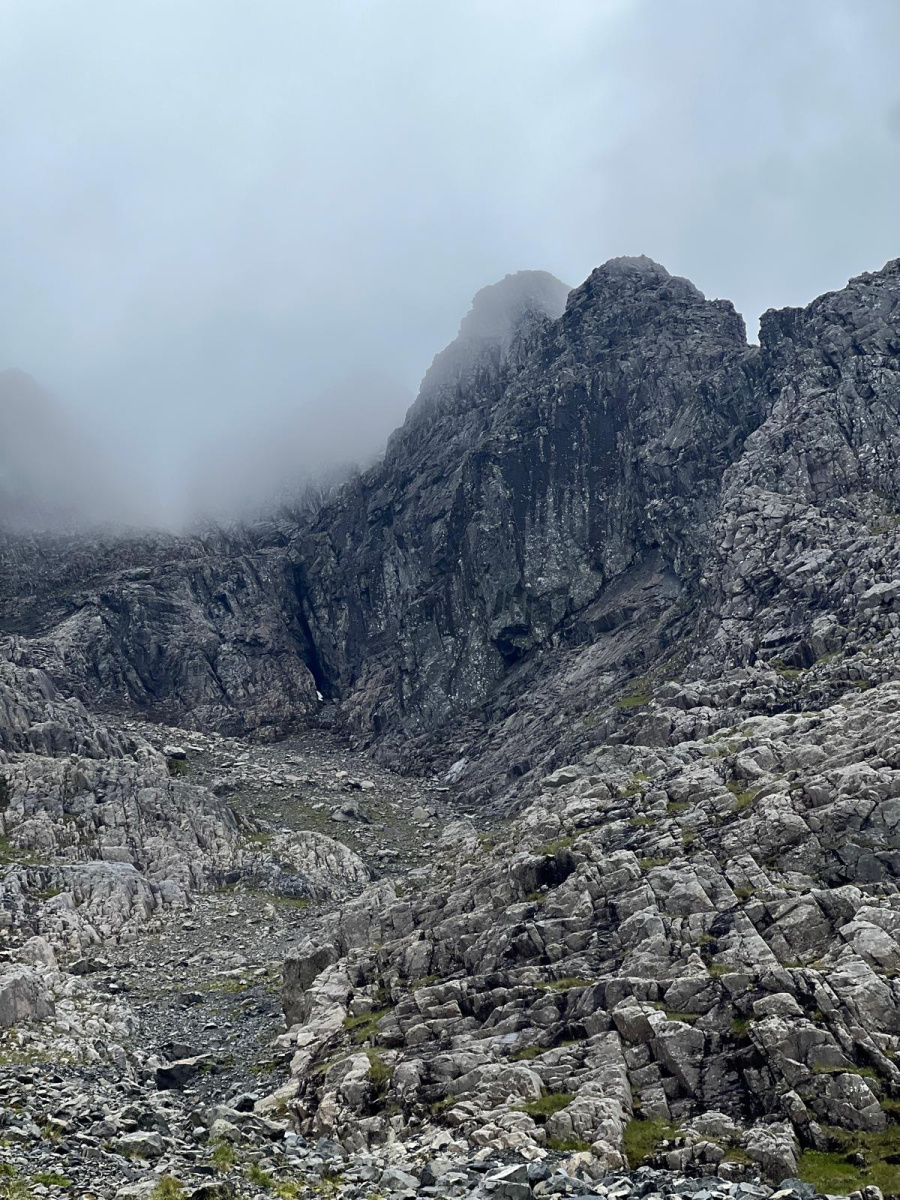
If possible, can you reflect on the 'enjoyment' or satisfaction you got from completing Echo Wall compared to that when you topped out on Lexicon and Bon Voyage or other top-end trad routes?
I’m not going to lie, I wasn’t always having fun up there on Echo Wall. The long approach and extremely unstable weather made the experience quite stressful, and there were several moments when I thought about giving in and going home.
Dave was always very open when he said he was looking to combine cutting-edge trad climbing with a mountain environment and I think he achieved exactly that. What he managed to do back in 2008 is incredible, and having now been through some of it myself, I find it even more impressive. However, since moving to France, I’ve definitely become a bit of a softy when it comes to the weather, and bringing in a whole load of other objective elements definitely takes away some of my enjoyment. I like climbing because I like climbing, not because I like climbing as well as I can with all the cards stacked against me.
Finally, before we widen the questions a little there’s the thorny issue of grade to look at. As ever, it’s accepted that a route can never be summarized simply by giving it a grade and that there’s so much more to both a route and the experience of climbing it than just the grade. However, climbers – and not least future guidebook writers - will undoubtedly be very interested in your thoughts on the grade for Echo Wall.
Echo Wall always 'sounded' like it would be E11 given Dave’s original assessment of F8c, or thereabouts, sport climbing difficulty coupled with poor protection/rock whilst facing a serious/ground-fall/death scenario. That’s quite different to either Lexicon with its run-out but 'safe' F8b+ sport climbing or say Bon Voyage which has F9a sport climbing with big swinging falls; as we know Neil offered E11 for Lexicon whilst ultimately you gave Bon Voyage E12. Whilst talking recently about how he grades routes, Dave himself offered E10 as a retrospective grade for Echo Wall. Have you had time since your successful second ascent to process your own thoughts and cement your view on the probable grade yet and if so, what are your thoughts?
I’m right in the middle of processing my thoughts regarding the grade of Echo Wall, so I might disappoint you with a slightly wandering reply. I think I’m not the only one who believed Dave originally thought Echo Wall might be worth even more than E11, and certainly eGrader (for whatever you think that might be worth) would agree that 8c or harder climbing with a death fall is firmly in the E12 bracket. Some of you may have seen the video that Dave released a few months ago where he talks in detail about how he grades his hardest routes, and whilst I can’t say I agree with everything he says, I definitely agree with the point he makes about things not only being about the numbers. Numbers (especially the French sport grade of a route) give you a good idea of where to start from, but there are so many other things at play.
After 20 years of fairly hard trad climbing (with a few grade-related ups and downs) I feel like I’m starting to get a pretty good gut instinct for these things, as well as a more global idea of how the difficulty/danger of the worlds hardest trad routes stack up against each other on paper.
Echo Wall is a perfect example of how the numbers only tell you half the story. The location and the conditions in which you will probably have to climb mean you need to be several grades better than the route might suggest to even have a chance of doing it. I think this is what Dave was trying to say all along that a lot of us misunderstood - the climbing on Echo Wall is not F8c+/9a, but you need to be F8c+/9a fit to stand a chance of doing it.
Widening the subject, can we look at why you think Echo Wall has taken so long to get repeated? Firstly, it’s not unusual that top-end routes stay unrepeated for some time; Steve McClure’s Mutation was only just repeated by Will Bosi for the first time after twenty-odd years. Echo Wall is clearly a considerable logistical and physical challenge and hence at a massive disadvantage compared to say “outcrop” routes; do you think it’s that or was it the difficulty/seriousness that’s been the issue or a combination of these factors keeping potential suitors away?
Although the two routes are clearly very different, I think you’ve made an interesting and fairly accurate comparison between them. Both Mutation and Echo Wall were first climbed by specialists of that style and both were way ahead of their time. Whilst Raven Tor is clearly not as complicated to access as Ben Nevis, the conditions down there can be incredibly fickle, especially for climbing on the minuscule and sloping edges of a route like Mutation. To climb Mutation you need to be much stronger than the route so that you can do it when conditions are less than perfect, or you need to be incredibly lucky. I think you could say exactly the same for Echo Wall.
Now you have repeated Echo Wall do you see further repeats coming in say the way that Parthian Shot was repeated after Seb Grieve’s second ascent or say Indian Face after Nick Dixon’s second ascent or is Echo Wall perhaps more 'unique' than that and might it be destined for a long and quiet 'retirement'?
Now that the route is clean and some of the mystery has been stripped away, I could definitely see more repeats coming in the near future. Even so, getting up there and getting on the route is a serious logistical commitment, and moving around efficiently on the climb takes a lot of knowledge about rope work and gear placement. It would be a big ask for a strong/fit climber with relatively little trad experience, I’d more likely put my money on someone like James McCaffie or Steve McClure who have the ability and the experience.
Do you think Echo Wall might see any interest from international stars?
Stranger things have happened, but I seriously doubt it. Most climbers living away from the UK are a little like me in that they like climbing when the sun is shining.
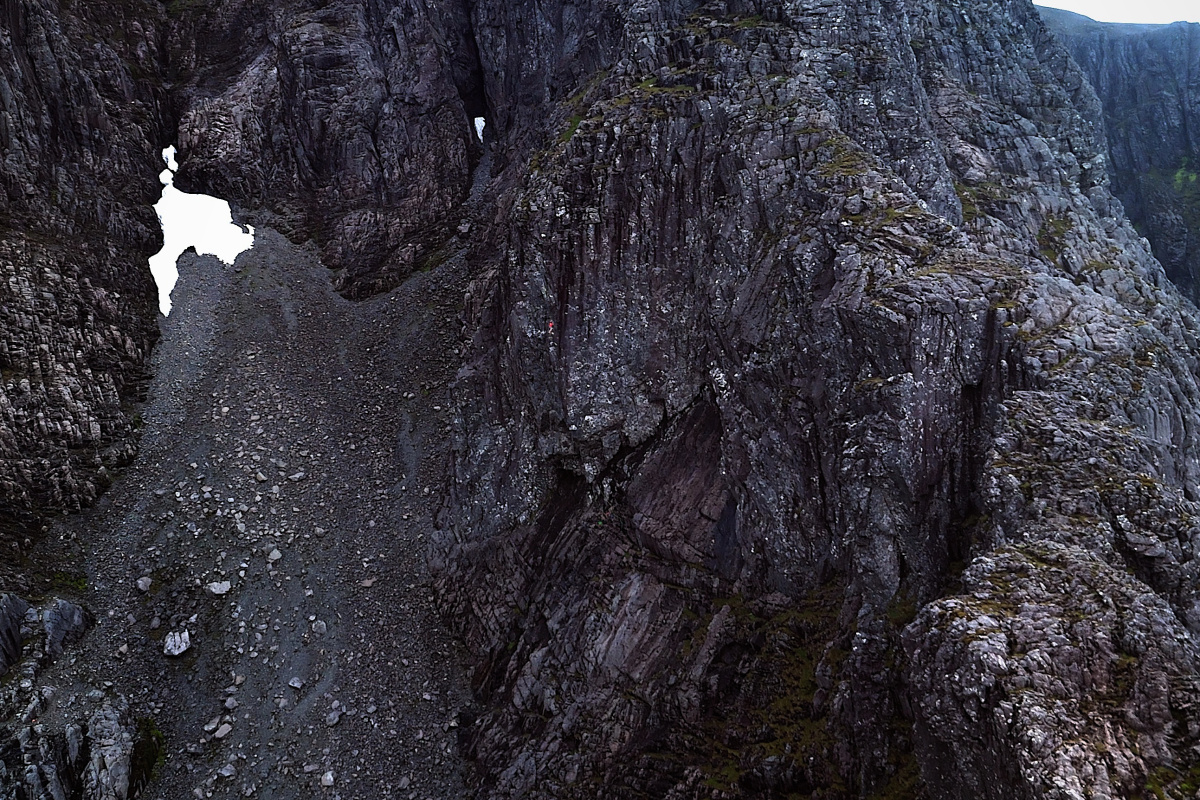 Perhaps we can zoom out even further now and consider the wider position of the top end of trad climbing and specifically the possible direction of travel. Obviously, it all depends on finding suitable projects but do you think we’re likely to see what might be considered the convergence of hard trad and hard sport climbing with more routes like Bon Voyage (ie. sport climbing hard but 'safe') or do you think more routes like Echo Wall which are not as hard but more dangerous might follow as climbers get stronger and can better “control” the more mental side of hard/dangerous trad
Perhaps we can zoom out even further now and consider the wider position of the top end of trad climbing and specifically the possible direction of travel. Obviously, it all depends on finding suitable projects but do you think we’re likely to see what might be considered the convergence of hard trad and hard sport climbing with more routes like Bon Voyage (ie. sport climbing hard but 'safe') or do you think more routes like Echo Wall which are not as hard but more dangerous might follow as climbers get stronger and can better “control” the more mental side of hard/dangerous trad
Whilst I think there is probably more potential for extremely bold, extremely hard trad routes I think there will be more progression in the harder and safer category. Whilst it is quite easy for a strong sport climber with a bit of alpine experience to transition to run out but safe trad, it’s another thing altogether to learn to deal with the reel probability of dying if you fall. There has been a general shift away from this style of extremely bold climbing over the last 40 years as climbers have discovered how to physically train themselves to never before imagined levels. The progression in that direction is seemingly endless, whereas dying due to a foot slip is dying due to a foot slip, and there is only so much mental preparation one can do.
There’s a lot of 2024 left now for you to sink your teeth into; do you have a feeling for what is next on your agenda?
Next up it’s Caro’s turn. She’s hoping to go back to Greenspit this autumn and I will be in full-on support mode for that (Daddy Daycare).

